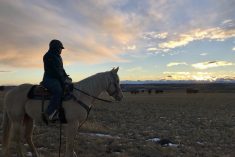Much has been written about omphalophlebitis (navel ill) in calves. The bovine species appears to be fairly susceptible to developing these infections. The wet, damp environment calves are sometimes born into, often in close confinement, increases the incidence. Fighting against this trend is the growing tendency of producers to calve later in the year on grass. Spreading the calves out in a drier environment has greatly decreased the incidence of navel infections.
Other ideas that prevent navel infection are sufficient colostrum intake to boost the resistance of the newborn calf, and in some cases, long-acting prophylactic antibiotics. These drugs may be prescribed by veterinarians for herds that have a higher-than-normal incidence of navel ill.
Read Also

Reintroducing fire to Saskatchewan pastures
Pastures evolve over time. Woody plants and shrubs, which cattle can’t eat, may encroach on natural grasses. Invasive species, such…
As a rule we have a higher incidence in operations that calve early and cycle calves through warm barns. This environment also encourages foot rot organisms to accumulate over time. The rule here is to try and establish a calving area that can be easily disinfected. And use it only for cows that really need assistance. Ideally it would be a concreted area with a maternity pen and a floor drain so the area can be cleaned and disinfected quickly each time it is used.
Over the years I have tried many things to prevent navel ill, even going to use of human umbilical clamps but I found they caused more problems than they were worth.
One thing veterinarians have recognized is a higher navel infection rate with caesarean sections. If a producer recognizes the need for a C-section early then the argument that these calves are stressed is moot. There is no stress on calves coming out through a caesarean incision unless the intervention was delayed or a major attempt was made to pull the calf beforehand. With a caesarean delivery the calf is essentially coming out backwards and the navel cord rips off very short to the body. The calf needs the long protective shroud of the umbilicus to prevent infection from wicking up inside.
There are a couple of ways to prevent this from happening. At our clinic when the calf is coming out through the incision we grab it and physically break the protective shroud quite a distance from the navel (12-16 inches). This is about the natural spot where the umbilicus breaks off.
Dr. Gordon Adkins at the University of Calgary Veterinary Medicine (UCVM) has a different method that is equally effective and a more natural recreation of the real event. As the calf is coming through the incision he pulls the entire umbilicus back between the back legs. This mimics exactly how the umbilicus breaks off in a normal delivery and he has had great success at doing this. Success means the umbilical shroud remains intact over a foot (30 cm) long. This definitely prevents infection from wicking up inside.
If any of your females do need caesarean sections I would recommend you mention this to your veterinarian. Both these methods are easy to do and will greatly decrease the incidence of navel infection in these calves. If the navel still breaks off short or the calf flops out of the incision before this can be done then perhaps they should be put on prophylactic antibiotics.
A short navel is one instance where I do recommend that you consider disinfecting the navel area. Just make sure you use a product that is recommended by your veterinarian, one that is not too harsh. Strong iodine solutions actually cause more inflammation and worsen the condition. This is one reason why we do not routinely recommend applying any treatment directly to the navel.
The next issue to tackle is calves that present backwards which, as you may guess, rip off short as well. Generally these births are being assisted so someone is present. The question is how do we break off the shroud internally without breaking
the vessels, as the calf still has to be delivered. That is a question for the future as these backward calves may have delayed deliveries, sometimes lack oxygen, are slower to rise and suckle all of which predisposes them to navel infection.
Whether it be that calves are lost or develop joint infections and must be put down or calves that have a slight pus discharge from the navel area, all are losses to the beef industry. Calves with lingering navel infections gain less weight and some that go on to become yearling bulls develop infections in their secondary sex glands rendering them infertile.
These are all good reasons to try to keep navel infections down to a minimum on your farm.
I will keep you posted if we find a way to break the navel shroud internally on those backwards calves. In the meantime I would recommend talking to your veterinarian about prophylactic antibiotics on backwards calves or any that have their navel ripped off short.
Closely examine the navel cord on newborn calves and you will see what I mean. Other than that, have a great calving season with a minimum of problems and a very low death rate.















